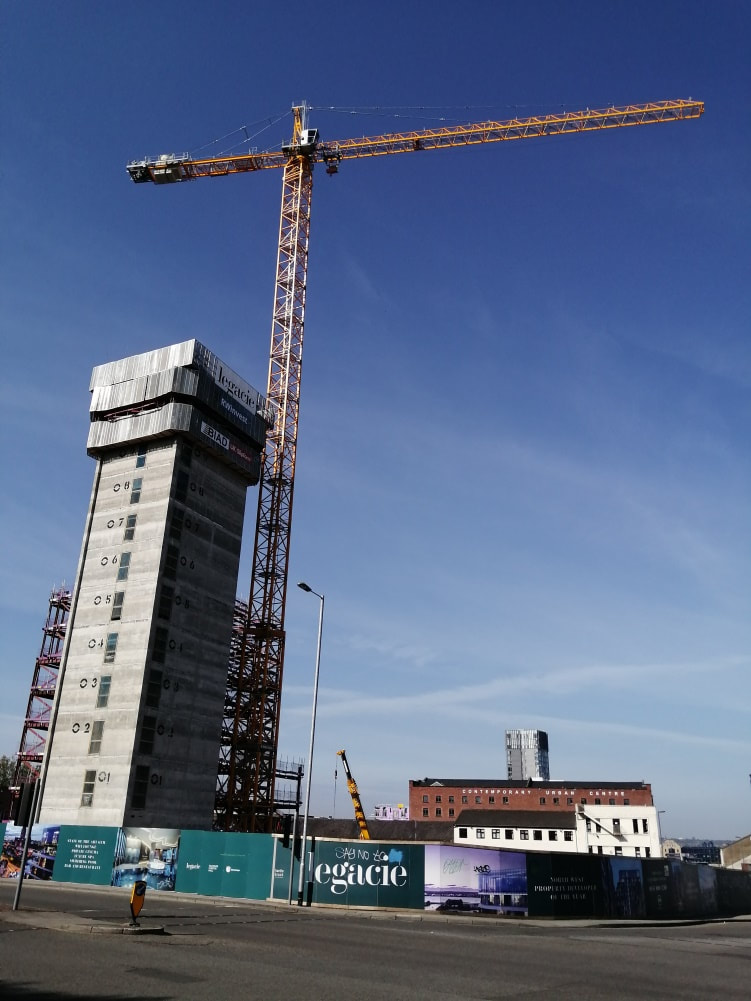|
Prayer for Liverpool
A striking aspect of the Liverpool skyline is the number of tower-cranes. Last year, I counted over a dozen as I looked back towards the city from the Mersey Ferry. Tower-cranes, love them or loath them, definitely are signs of economic investment and aspiration. Many would regard them as signs of hope and regeneration, I am sure. From my top-floor study in Cathedral Close, I am blessed with a splendid vista looking across the city centre across the Mersey and the Wirral, with the currently out-of-bounds mountains of north-east Wales in the distance. I can see a good many of these tower-cranes. In fact, their movements have been a re-assuring sign of encouragement to me during the lockdown since at least that part of the economy has continued to operate apparently normally, when many other areas of activity have shut down. Let’s hope that, post Covid, there will be tenants and businesses who can afford to occupy the towers and other buildings that the tower-cranes are busy building. Being an engineer by training, I know that tower-cranes don’t just happen – they have to be carefully designed, manufactured and operated. In some unremarkable offices and laboratories, engineers will have done their finite-element analyses, materials testing, scale-modelling and wind-tunnel testing to produce a structure that is immensely strong, able to flex safely in the wind, and yet light enough to be hoisted aloft. And how do you erect and dismantle a tower crane? That I was able to witness in the last few weeks as a new crane was put up just below us (the one in the picture) and one taken down, a bit closer to the river. Both required huge mobile cranes to do the honours, plus a team of workers in hi-viz gear performing some gravity-defying stunts way up above the streets of Liverpool. It wasn’t quite like those iconic pictures of the remarkable men who built the early New York skyscrapers; perhaps you have seen black-and white pictures of them deftly walking along RSJs hanging hundreds of feet in the air and even sitting on them to eat their packed lunches? I don’t think that the HSE would be too impressed by that these days. But I remember thinking that I am glad that I don’t have their job. I’m better with heights than I used to be but not quite that good! Whilst there are no references to tower-cranes in the Bible, towers crop up quite a bit, and not always in glowing terms, it has to be admitted. In Genesis 11:4, the nations of the world combine their efforts to construct a huge tower: “Come, let us build ourselves a city, and a tower with its top in the heavens, and let us make a name for ourselves.” The Tower of Babel, possibly an enormous ziggurat, was there seen as a sign of human hubris and of us trying to engineer a way to immortality and god-like status. Whereas only God can occupy that place and provide the means by which humans can reach him. So God sends confusion of language and communication in order to thwart their efforts. Towers 0, God 1. Towers were also signs of strength as they formed an essential component of the defences of a city or town: “He [King David] said to Judah, ‘Let us build these cities, and surround them with walls and towers, gates and bars; the land is still ours because we have sought the Lord our God; we have sought him, and he has given us peace on every side.’ So they built and prospered.” In the New Testament there has clearly been a serious accident with the Tower of Siloam falling down and killing eighteen people (Luke 13:4). Asked whether this was divine judgement, Jesus appears to imply that it is more likely to be an accident caused by human error in building a sub-standard tower. Some of the most positive ‘tower’ metaphors are to be found in the Psalms and the Proverbs. God is likened to a ‘strong tower’ on several occasions (e.g. Proverbs 18:10): “The name of the Lord is a strong tower; the righteous run into it and are safe.” In Psalm 61:2b-3 David cries out to God, “Lead me to the rock that is higher than I; for you are my refuge, a strong tower against the enemy.” Doubtless the watchman of Psalm 130:6 is atop a tower as he scans the distant horizon for the signs of the dawn – a picture of God’s coming salvation. Perhaps those are helpful metaphors to us in lockdown, where the very foundations of how we order our lives and civilisation are being shaken to the core. In the midst of all the uncertainly God is still unchanging, a tower built on firm foundations. He is happy for any who seek him to run into his refuge and be comforted – which literally means to be given strength. Equally, he is content that, safely in the tower of the Lord, we watch patiently and faithfully for the dawn when the world will return to normality, albeit a new one, and we can re-connect with each other and the things that we enjoy doing together. So, if you are able to get out for daily exercise, or have some kind of view from your window, why not have a gaze this week at the towers and tower-cranes of Liverpool? Maybe you can see the tower of Liverpool Cathedral (it seems to be visible from all over the city) which survived the bombing of WW2 and points our gaze even above itself into the heavens. Let us be reminded that God is our strong tower and the place from which we can look out for better times to come. Canon Neal While you're here: Why not prepare for next Sunday's worship? Our preparation sheet for adults and for children can be accessed by clicking on the Resources tab of this website: https://www.prayerforliverpool.org/prayer-resources.html.
0 Comments
Your comment will be posted after it is approved.
Leave a Reply. |
supporting you during these uncertain times AuthorLiverpool Cathedral is a place of encounter. Built by the people, for the people, to the Glory of God Archives
September 2022
|
|
Prayer for Liverpool
brought to you from Liverpool Cathedral St James Mount Liverpool L1 7AZ |
Liverpool Cathedral is a place of encounter.
Built by the people, for the people, to the Glory of God www.liverpoolcathedral.org.uk |

 RSS Feed
RSS Feed
